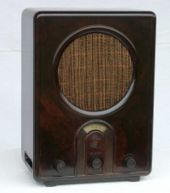Bakelite
Bakelite and Bakelite are trademarks (trademarks) for various early plastics , originally (from 1909) Bakelite GmbH in Germany , a little later also Union Carbide Corporation in the USA . The registered trademarks belong to Hexion GmbH.
The first fully synthetic, industrially produced plastic was manufactured and marketed under the name Bakelite , which was developed in 1905 by the Belgian chemist Leo Hendrik Baekeland and named after him. The thermosetting resin is a phenol resin based on phenol and formaldehyde . Molded parts made of this plastic are produced by compression molding and curing a phenolic resin-filler mixture in a heated mold. Other plastics were later marketed as Bakelite, such as variants of phenoplasts, aminoplasts , epoxy resins and polyester resins .
history

Baekeland experimented with phenol and formaldehyde in the early 20th century. He discovered that these substances polymerized to a synthetic resin in an exothermic reaction . After removing the resulting water, the still soft, warm mass (molding mass) can be pressed into molds and hardened by heat and pressure. A patent was granted for the corresponding process in 1907.
On February 5, 1909, Baekeland presented his discovery under the name Bakelite at the New York Club of Chemists on 55th Street.
Baekeland quickly recognized the new properties of the material and founded Bakelite GmbH in Erkner near Berlin on May 25, 1910, together with the RÜTGERS-Werke .
At that time phenol was still produced in large quantities as a by-product of hard coal distillation , and Baekeland began to produce Bakelite in large quantities.
After the Second World War , the Bakelite plant in Erkner was dismantled and nationalized. In 1948 the VEB Plasta Erkner was founded there. The owners moved the company headquarters to Letmathe near Iserlohn in the western zone . In 1957 phenolic resin production began in Duisburg-Meiderich , where epoxy resins have also been produced since 1959 . In 1976 the Frielendorf plant near Kassel (formerly Hoechst AG ) was added.
At the end of the 1980s, Bakelite AG began acquiring companies in other European countries.
End of April 2005, the Bakelite AG from Borden Chemical Inc. , headquartered in Ohio bought, which in turn two divisions Resolution Performance Products LLC and Resolution Specialty Materials LLC to the Hexion Specialty Chemicals Inc. merged. These merged business areas also included the former Bakelite AG , which was thus merged into Hexion, which is one of the world's leading manufacturers of thermosetting plastics.
Manufacturing
The polycondensation for the production of phenol-formaldehyde resin begins under acid catalysis with the following reaction:
The dimer 3 formed can then react again under the influence of an acid with phenol 1 and formaldehyde 2 with elimination of water. This is how a trimer forms . Many other condensation reactions of this type ultimately result in Bakelite, a cross-linked macromolecule.
properties
After the plastic has cooled and hardened, it is resistant to mechanical influences, heat and acids. In contrast to thermoplastics , Bakelite cannot be deformed again even by heating. However, it is relatively brittle , so that objects made of this material can shatter, for example when hitting the ground.
Phenolic resins tend to darken and are therefore usually dark brown or black in color. The molding compound also contains additives such as wood flour , rock flour or textile fibers, which can cause colored marbling .
Bakelite is also very durable. During World War II, the US Navy probably lost a Bakelite component marked VP-101 . It drifted in the Pacific garbage vortex for possibly 60 years before it was swallowed by a Laysanal bat.
use




After the “pressure-heat” patent expired in 1927, the production method spread rapidly - in the 1930s there were already several hundred pressing plants and manufacturers of phenolic resin molding compounds in Germany. The "typing" of the molding compounds and the pressing tool products by an association of manufacturers was essential.
Bakelite products are household and kitchen items (handles for windows, doors, pans and saucepans, waffle irons), telephones ( model W48 ), decorative objects, costume jewelry, weapons (fittings), office items, light switch and socket housings, track bodies for model railways from Trix Express (1935 to 1955), housings for devices, radios and transformers as well as generally for electrical and thermal insulation material. These properties predestined Bakelite for use in motor vehicles (ignition coil and spark plug connectors, distributor caps, insulation of carburettors and fuel pumps from hot engine components). The body parts of the Trabant were made of cotton-fiber-reinforced phenolic resin.
Bakelite was used in colored form as a substitute for gemstones, amber and ivory. Bakelite, used instead of ivory, was marketed under the name "Ivorine".
Phenol-formaldehyde resin is still used when mechanical and thermal resistance, low flammability and chemical resistance are required, for example in grinding disks, friction linings, filter papers, refractory materials, insulation materials , machine operating elements and for the impregnation or impregnation of wood and paper materials (Printed circuit boards).
Similar materials are used as heat shields .
Bakelite products are often sought after collector's items because of their design and their importance for everyday culture and industrial history. Lovers claim that bakelite creates a better feel when compared to modern plastics.
Exhibitions
In the Museum of Applied Arts (MAK) the exhibition shows Bakelite. The Georg Kargl Collection from July 15 to October 26, 2020 around 300 objects designed from or with Bakelite. Georg Kargl (1955–2018) was a gallery owner in Vienna.
In 2003 a Bakelite Museum was opened in Kierspe . Several thousand exhibits are shown in changing exhibitions. A large part consists of the collection donated to the Heimatverein by the Kiersper factory owner, Carl-Heinz Vollmann from Reppel & Vollmann ("Revolit" products).
See also
- Hard paper as a base material for printed circuit boards
- Novotex (phenolic resin fiber composite )
- other thermosets: melamine resin (an aminoplast , can be produced in white)
literature
- LH Baekeland: Bakelite, a new synthetic resin. In: Chemiker-Zeitung 35, No. 33, 1909, pp. 317-318.
- Dietrich Braun, Gerd Collin: 100 years of Bakelite. In: Chemistry in Our Time. Vol. 44, No. 3, 2010, ISSN 0009-2851 , pp. 190-197.
- Silvia Glaser: Bakelite. In: Historical plastics in the Germanic National Museum. Verlag des Germanisches Nationalmuseums, Nuremberg 2008, ISBN 978-3-936688-37-5 , pp. 14-20.
Web links
- amsterdambakelitecollection.com
- bakelit100.de (traveling exhibition)
- bakelit.ch (private Bakelite object collection near Basel , CH)
- bakelitmuseum.de
- juliensart.be ("Virtual Bakelite Museum", Ghent , Netherlands)
- stiftung-nrw.de: German Bakelite, German Duroplast Museum
Individual evidence
- ↑ a b c Entry on phenolic resins. In: Römpp Online . Georg Thieme Verlag, accessed on June 12, 2014.
- ↑ Registration number 505667 Register Information German Patent and Trademark Office
- ^ Wolfgang Kaiser: Synthetic chemistry for engineers. 3rd edition, Carl Hanser, Munich 2011, p. 13.
- ↑ Irene Meichsner: Departure into the age of plastics . In: Calendar sheet. Deutschlandfunk February 5, 2009.
- ^ Company history ( Memento from April 4, 2004 in the Internet Archive ) on the former website of Bakelite AG.
- ↑ Hans-Dieter Jakubke, Ruth Karcher (Ed.): Lexikon der Chemie. Spectrum Academic Publishing House, Heidelberg 2001.
- ^ Oceans of Waste. Seattle Times, April 23, 2006, accessed January 24, 2010 .
- ↑ Peter Wulf Hartmann: The large art dictionary. Entries Bakelite and Ivorine .
- ↑ Bakelite in the MAK: "Material of 1,000 Possibilities" orf.at, July 18, 2020, accessed July 18, 2020.
- ↑ Bakelite. The Georg Kargl Collection mak.at, July 15, 2020, accessed July 18, 2020.
- ^ City of Kierspe (local history museum): Bakelite Museum , accessed on July 18, 2020.



